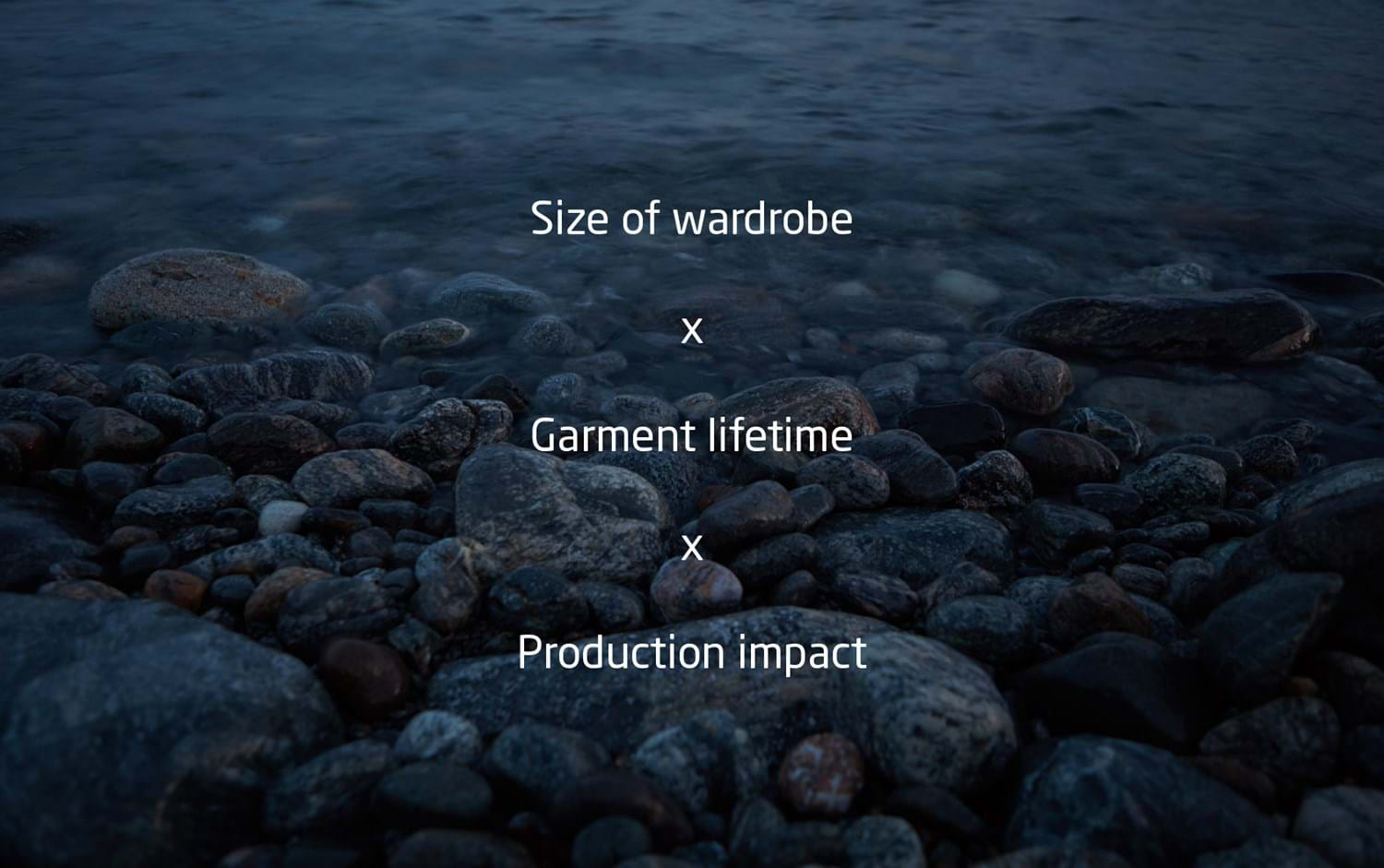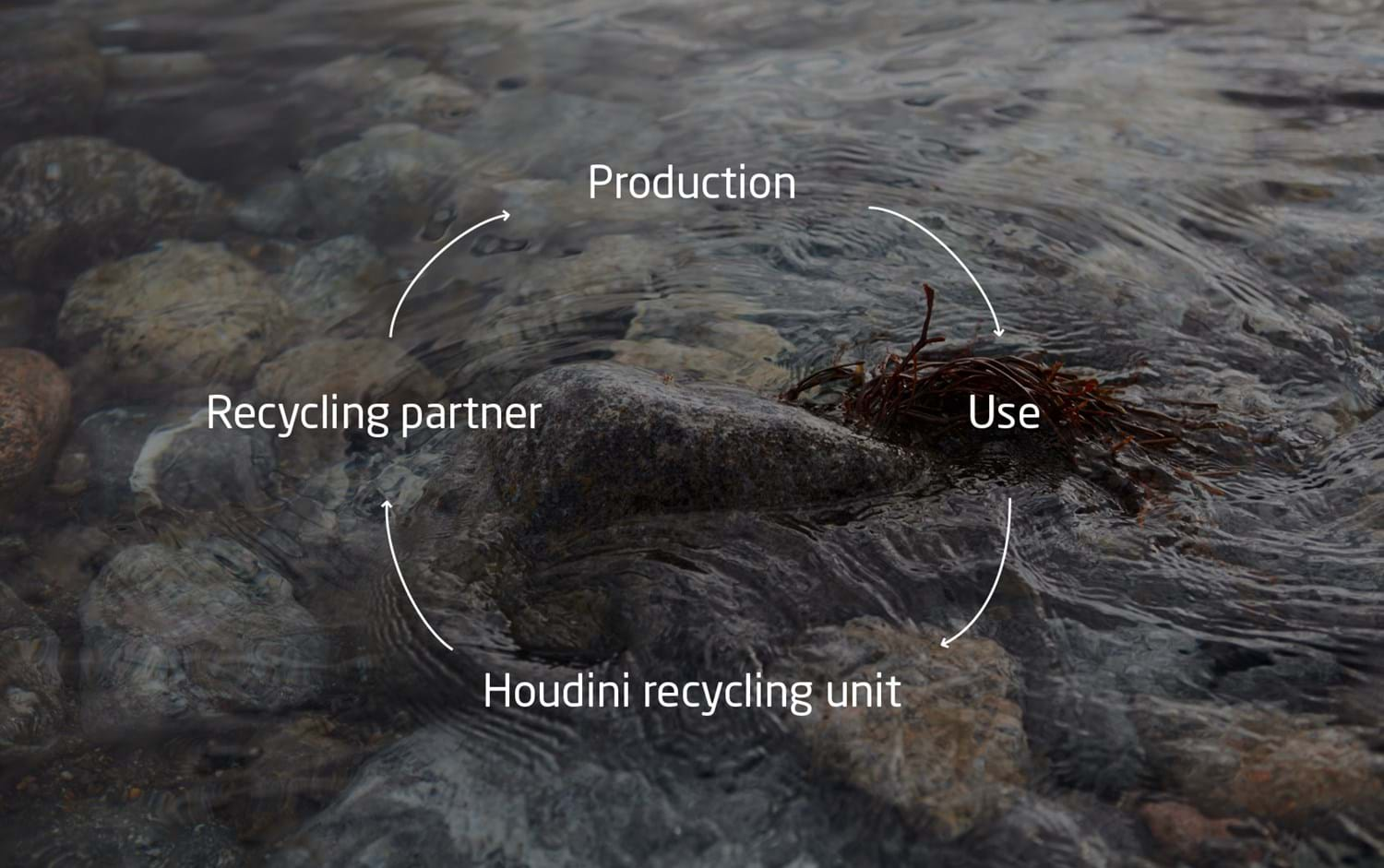Circular design principles
We don’t consume materials. We simply borrow them.
We choose to see the resources we use as resources borrowed from the planet and Houdini as the custodian of these, responsible for handing them back to the planet in good shape. A circular design perspective and a working take-back system for all Houdini products is therefore a given. Together with our end users we treat worn-out garments as they were intended when designed - as a resource to recycle, rather than as waste. Houdini launched its first recycled garment in 2006 and now 72% of our collection is fully circular.

The impact of a wardrobe (or an apparel company)
The total environmental impact of anyone’s wardrobe can be calculated using the following formula: Product impact x Size of wardrobe x Life you choose to live. Similarly an apparel company’s impact is: Product impact x Volumes produced x Lifestyle promoted. The Houdini design philosophy has evolved as a response to all these factors. An absolute majority of the decisions we make can be traced back to this formula and result in the design of circular solutions. Products that are circular by design. Products that enable a smaller wardrobe that works for most parts of your life and that will last, both in terms of quality and style. Products that you fall in love with and stay in love with. Products that you can care for, repair, reuse and share for many year before they eventually end up being recycled.
The Houdini design checklist
We have a checklist that all new garments have to pass before we put them into production. In a world overflowing with cheap gadgets and fast fashion, there are some things that last. That cease being items in your drawers and instead become lifelong companions. Items that by their quality, functionality and style simply don’t need to be replaced. But how do you make those lasting items? When it comes to technical sportswear, we have identified a number of questions that we ask ourselves before putting anything into production.
- Does this product deserve to exist?
- Will it last long enough?
- Is it versatile enough?
- Will it age with beauty?
- Nothing added that isn’t needed, right?
- Is it fit for sharing, reparing, remaking and reselling?
- Does it have a next-life-solution?
The linear reality of today
Today, the textile industry is almost always a linear process, meaning that resources are extracted, transformed into products that are sold, used and then thrown away at the end of their lifetime. All production has an impact, but if we manage to close the loop, we can save resources, lower the impact of production and reduce the stream of waste.

Today, more than 97% of all materials that go into textile production is virgin materials and 73% of it is never used again.
The transformation into circular
In order to design circular product systems our policy is to keep the raw material as pure as possible and never mix natural and synthetic fibres. When we use wool, we only blend it with other biodegradable fibres to ensure a biodegradable product. When we use synthetic fibers, like the polyester in Mono Air Houdi, we only use one material (mono materials). This enables a circular lifespan where the fabric can be recycled endlessly in a circular recycling system without lowering the quality.

This figure shows how the biological and technological cycles can be maximized to achieve an energy efficient, circular production system.
Mono Air Houdi is made from 73% recycled polyester and 27% virgin polyester. Production of polyester, especially recycled polyester, requires less water to produce than many other fibers, and by working closely with Polartec we can ensure the production is made in a more sustainable way. The 73% recycled polyester in Mono Air Houdi comes from post consumer waste, mainly PET bottles. The 27% that is not from recycled sources is a special kind of stretch polyester yarn that is not made with recycled polyester at this time. Hopefully we can make the garment in 100% recycled polyester soon.
In a world overflowing with cheap gadgets and fast fashion, there are some things that last.

Circularity without compromising on performance
If we want to ensure a circular product lifespan and reduce micro plastics, why even use a synthetic fiber? The answer is performance. Polyester has a long list of pros: Polyester fabrics can be made very light, highly durable, they dry quickly and they wick away moisture efficiently. Mono Air Houdi is designed for hard use in demanding conditions and the performance benefits of polyester are hard to match.
Recycled polyester is a great performance fabric and has a significantly lower impact than many other textiles. Graphics from Houdini Planetary Boundaries Assessment.
Garments made from polyester are also easy to take care of and are not worn from washing in the same way as most natural fibers. A polyester fiber can also be reused again and again, without impairing any of its fantastic properties. Most of our polyester garments are made from recycled fibers, many are recyclable and most are both.
With that said, synthetics vs naturals is also a matter of personal preference and we make fantastic performance garments in both.

Closing the loop with a take-back system
Besides making circular garments, it’s essential to have a system in place to recycle them. Few regions have public recycling systems for textiles (because not so many textiles are recyclable). At Houdini, we have a recycling system with recycling units in all our own stores and at many retailers. We collect all garments and then send them forward to our recycling partners. We accept all worn-out Houdini garments, even the ones that are not recyclable at the moment. We will make sure nothing goes to waste and that the raw material can be used for new products. If you have a Houdini garment that is not recyclable, you can still return it. Recycling solutions are developing and we don't want to destroy any potential resources.

Longer lifespan to slow down the wheel
Product lifespan is extremely important in a circular design system. All production has an impact and circular materials have little benefits if we keep producing and consuming products in the fast pace as we do today. As producers we need to build a business based on long lasting garments, not fast trends and disposable products. As consumers we can contribute by buying less, buying better and caring for the things we have.
Do more with less
As we saw previously in the model for the environmental impact of a wardrobe, size of wardrobe is an important factor. Therefore it’s important for us to design products that enable our customers to have a smaller, smarter wardrobe. Our garments are wearable multitools that lets you do more, experience more but still use less garments. We design our garments to work for as many different activities as possible and feel right into as many different contexts as possible. We believe that a well designed garment can work just as well for biking, business meetings or boulder climbing.
Contact the crew:
Jesper Danielsson, Head of Design
Malin Wetterborg, Textile engineer
Shop Mono Air Houdi
-40%
Available Sizes True Black:
XS
S
XL
Light and durable hooded fleece jacket for women. Features an innovative fabric construction that prevent microfiber shedding and is made with recycled and recyclable fibers.
$ 230.00
$ 138.00
-40%
Available Sizes True Black:
XS
Light and durable hooded fleece jacket for men. Features an innovative fabric construction that prevent microfiber shedding and is made with recycled and recyclable fibers.
$ 230.00
$ 138.00
Houdini Sportswear. All rights reserved.